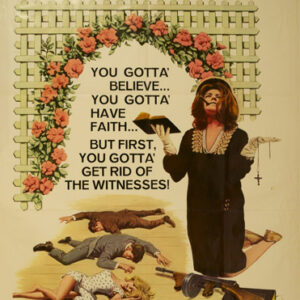calsfoundation@cals.org
Bloody Mama
In 1969, Roger Corman, who had found success directing and producing low-budget exploitation films for American International Pictures, chose as his next project a fictionalized account of the exploits of the infamous Ma Barker and her gang. After a scouting trip to Arkansas, Corman decided to shoot the film in the Ozark Mountains and around the Little Rock (Pulaski County) area. Corman described the experience as one of the “smoothest and most successful” shoots of his career.
For the part of the notorious Ma Barker, Corman had only one actress in mind—Oscar-winner Shelley Winters. After agreeing to the role, Winters helped Corman cast the film. She showed him a video of Robert De Niro performing in a low-budget Brian De Palma film, which convinced Corman that De Niro was the right person to portray Barker’s drug-addicted son, Lloyd. She also recommended Robert Walden—whom she knew from the New York stage—for his first screen role, as Barker’s youngest son, Fred. Walden would later return to Arkansas to live, helping organize the Winthrop Rockefeller Institute’s Film Forum.
De Niro’s dedication to his craft was evident even at this early point in his career. He arrived in Arkansas before the crew so he could explore the area and work on his accent. By the time the rest of the cast arrived, De Niro, who was born in New York, had achieved such a good southern accent that Corman asked him to help the other actors with their dialects.
Principal photography on the four-week shoot began on August 12, 1969. Approximately 600 Arkansans were employed in the shooting of the movie, some for one day and some for the duration of the schedule. Shooting locations included Baxter, Marion, Izard, and Pulaski counties. Among the extras hired were the mayor of Mountain Home (Baxter County), the Baxter County judge, and several officers from the Little Rock Police Department, North Little Rock Police Department, and Arkansas State Police. Musician Carlos “Bookmiller” Shannon, who was the subject of some of Alan Lomax’s folk recordings in 1959, appeared in one scene, playing the banjo alongside other musicians from Stone County.
The film follows the exploits of Ma Barker and her sons as they rob banks, gun down bystanders, and hide from the law. As with most exploitation flicks, the film is marked with numerous scenes of sex and violence. Ten people from Batesville (Independence County) who worked on the film as extras walked out when the production reportedly “really started getting gross.” The group, which included four students from Arkansas College (now Lyon College), were offended by scenes with nudity. The film’s violent content did not have the same effect, even though more than 5,000 rounds of machine gun ammunition were used in the shooting of the movie’s final scene.
The film, which premiered in Little Rock on March 24, 1970, received mixed reviews. The New York Times declared it “more honest and less pretentious” than the critically acclaimed Bonnie and Clyde (1967), which also followed the lives of real-life Depression-era gangsters, but Time magazine called it “a lurid little number” and “a hapless and bloody rehash” of the earlier film. The film was American International’s most successful movie in 1970, and Corman reported that it got “rave reviews and serious attention in Europe.” Corman would return to the state as producer in 1971 for Boxcar Bertha, directed by Martin Scorsese.
For additional information:
“Angry Shelly Winters, after Threat to Leave, Returns to ‘Mama’ Role.” Arkansas Gazette, August 22, 1969 p. 1B.
“Bloody Mama.” Internet Movie Database. http://www.imdb.com/title/tt0065481/ (accessed October 20, 2021).
Corman, Roger, with Jim Jerome. How I Made a Hundred Movies in Hollywood and Never Lost a Dime. New York: Random House, 1990.
Smith, George. “Actor Becomes Casualty as Ma Barker Filming Starts in N. Arkansas.” Arkansas Gazette, August 13, 1969, p. 16A.
Thompson, Howard. “‘Bloody Mama,’ Gangster Film, Begins Its Run.” New York Times, May 7, 1970, p. 62.
Ben Fry
University of Arkansas at Little Rock
 Arts, Culture, and Entertainment
Arts, Culture, and Entertainment Divergent Prosperity and the Arc of Reform, 1968–2022
Divergent Prosperity and the Arc of Reform, 1968–2022 Fighting Mad
Fighting Mad Arthur "Doc" Barker
Arthur "Doc" Barker  Bloody Mama
Bloody Mama 




Comments
No comments on this entry yet.